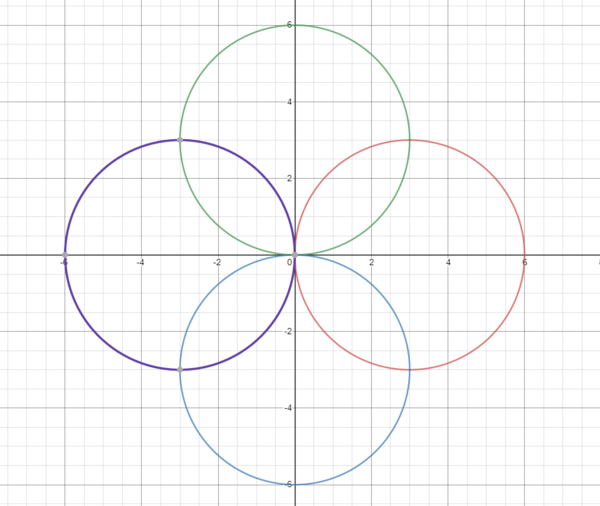Difference between revisions of "2021 AMC 10A Problems/Problem 19"
Arcticturn (talk | contribs) (→Remark) |
Arcticturn (talk | contribs) (→Solution 2) |
||
| Line 47: | Line 47: | ||
[[File:Image 2021-02-11 111327.png|center|600px]] | [[File:Image 2021-02-11 111327.png|center|600px]] | ||
| − | ==Solution 2== | + | ==Solution 2 (Guessing)== |
| + | Assume <math>y</math> = <math>0</math>. We get that <math>x</math> = <math>6</math>. That means that this figure must contain the points <math>(0,6), (6,0), (0, -6), (-6, 0)</math>. Now, assume that <math>x</math> = <math>y</math>. We get that <math>x</math> = <math>3 \sqrt 3</math>. We get the points <math>(3,3), (3,-3), (-3, 3), (-3, -3)</math>. | ||
| + | |||
| + | Since this contains <math>x^2 + y^2</math>, assume that there are circles. Therefore, we can guess that there is a center square with area <math>6 \cdot 6</math> = <math>36</math> and <math>4</math> semicircles with radius <math>3</math>. We get <math>4</math> semicircles with area <math>4.5 \pi</math>, and therefore the answer is <math>36+18</math> = <math>\boxed {(E)54}</math> | ||
| + | |||
| + | ~Arcticturn | ||
== Video Solution (Using Absolute Value Properties to Graph) == | == Video Solution (Using Absolute Value Properties to Graph) == | ||
Revision as of 09:42, 29 October 2021
Contents
Problem
The area of the region bounded by the graph of![]() is
is ![]() , where
, where ![]() and
and ![]() are integers. What is
are integers. What is ![]() ?
?
![]()
Solution 1
In order to attack this problem, we need to consider casework:
Case 1: ![]()
Substituting and simplifying, we have ![]() , i.e.
, i.e. ![]() , which gives us a circle of radius
, which gives us a circle of radius ![]() centered at
centered at ![]() .
.
Case 2: ![]()
Substituting and simplifying again, we have ![]() , i.e.
, i.e. ![]() . This gives us a circle of radius
. This gives us a circle of radius ![]() centered at
centered at ![]() .
.
Case 3: ![]()
Doing the same process as before, we have ![]() , i.e.
, i.e. ![]() . This gives us a circle of radius
. This gives us a circle of radius ![]() centered at
centered at ![]() .
.
Case 4: ![]()
One last time: we have ![]() , i.e.
, i.e. ![]() . This gives us a circle of radius
. This gives us a circle of radius ![]() centered at
centered at ![]() .
.
After combining all the cases and drawing them on the Cartesian Plane, this is what the diagram looks like:
![[asy] size(10cm); Label f; f.p=fontsize(7); xaxis(-8,8,Ticks(f, 1.0)); yaxis(-8,8,Ticks(f, 1.0)); draw(arc((-3,0),3,90,270) -- cycle, gray); draw(arc((0,3),3,0,180) -- cycle, gray); draw(arc((3,0),3,-90,90) -- cycle, gray); draw(arc((0,-3),3,-180,0) -- cycle, gray); draw((-3,3)--(3,3)--(3,-3)--(-3,-3)--cycle, grey); [/asy]](http://latex.artofproblemsolving.com/6/3/5/6352083edc8b0551fe5673e3d75e6debba348a74.png) Now, the area of the shaded region is just a square with side length
Now, the area of the shaded region is just a square with side length ![]() with four semicircles of radius
with four semicircles of radius ![]() .
The area is
.
The area is ![]() . The answer is
. The answer is ![]() which is
which is ![]()
Solution by Bryguy
Remark
This problem asks for the area of the union of these four circles:
Solution 2 (Guessing)
Assume ![]() =
= ![]() . We get that
. We get that ![]() =
= ![]() . That means that this figure must contain the points
. That means that this figure must contain the points ![]() . Now, assume that
. Now, assume that ![]() =
= ![]() . We get that
. We get that ![]() =
= ![]() . We get the points
. We get the points ![]() .
.
Since this contains ![]() , assume that there are circles. Therefore, we can guess that there is a center square with area
, assume that there are circles. Therefore, we can guess that there is a center square with area ![]() =
= ![]() and
and ![]() semicircles with radius
semicircles with radius ![]() . We get
. We get ![]() semicircles with area
semicircles with area ![]() , and therefore the answer is
, and therefore the answer is ![]() =
= ![]()
~Arcticturn
Video Solution (Using Absolute Value Properties to Graph)
~ pi_is_3.14
Video Solution by The Power Of Logic (Graphing)
Video Solution by TheBeautyofMath
~IceMatrix
See Also
| 2021 AMC 10A (Problems • Answer Key • Resources) | ||
| Preceded by Problem 18 |
Followed by Problem 20 | |
| 1 • 2 • 3 • 4 • 5 • 6 • 7 • 8 • 9 • 10 • 11 • 12 • 13 • 14 • 15 • 16 • 17 • 18 • 19 • 20 • 21 • 22 • 23 • 24 • 25 | ||
| All AMC 10 Problems and Solutions | ||
The problems on this page are copyrighted by the Mathematical Association of America's American Mathematics Competitions. 










